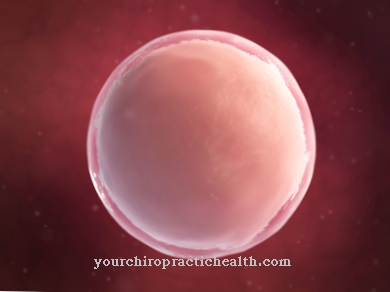The Cell adhesion or Cell adhesion is the adhesion of cells to one another or to other organic structures. This attachment force is one of the essential foundations of organic life, as it provides the concrete structure of the human body, for example.
What is cell adhesion?

Cells attach to other cells, different substrates or molecular membranes. In this way they are anchored in their environment. At the same time, the cells separate themselves from other cell formations, tissues and organs.
The cell adhesion also has the effect that weaker bonds are constantly being separated from stronger bonds between the cells, and a cell association is thus renewed and stabilized. The contacts of the cells with each other lead to mechanical cohesion, they secure the demarcation from existing external media and enable the development of direct relationships between cells or cell clumps. For example, after operations, injuries or broken bones, new human tissue is created.
Function & task
Thanks to cell adhesion, individual blood cells can also adhere to the inner walls of the blood vessels and thus separate themselves from flowing blood. Other blood cells are even able to move along the vessel walls. In this way, cells of the immune system can target sources of infection in the body.
These blood cells may even be able to cross the blood-brain barrier. This protects the brain from pathogens as well as toxins and messenger substances in the blood. Medicine has not yet been able to prove this phenomenon, but it is likely to be related to some neurological diseases that have not yet been fully explored.
When blood clots, the thrombocytes (blood platelets) form an adhesive bandage and stick more or less firmly to one another. The tissue of the skin or any internal organ is nothing more than a large, cohesive group of cells. The tissue cells are connected to the proteins of the extracellular matrix through cell adhesion. This intercellular substance consists mainly of connective tissue, which supplies the cells with nutrients and transmits neurological signals.
Illnesses & ailments
The development of infectious diseases is also related to cell adhesion. For example, numerous bacteria enter the body via the mucous membranes in the respiratory tract. They stick there and in this way get into the human organism, where they then reproduce successfully. The bacteria have adapted so well to the molecular structure of the mucous membranes that practically nothing can stop them in this way.
Inflammation is also directly related to cell adhesion in the body. They can change the adhesive properties of entire tissue layers by emitting fibrin.This acts like an adhesive and thus leads to connective tissue-like adhesions that can also affect blood vessels located there. Fibrin is a protein that is actually responsible for blood clotting. But by triggering the tissue growth, it can impair the normal work of the affected organs or make it impossible. In these cases, tissues or organs grow together that normally have no connection with one another.
An example of this type of process is the so-called abdominal adhesions, a strand of scarring in the abdominal cavity. It can turn out to be completely harmless as long as the adhesion mainly affects the supporting and not the organ-forming tissue. For example, an intestinal obstruction can cause major complications, as can an adhesion in the abdominal cavity. It can lead to an intestinal rupture, which can be life-threatening.
A restriction or even an interruption of the blood supply due to adhesions in the abdominal area is also possible. In the worst case, the affected tissue can die here. A surgical intervention would be inevitable. Adhesions after irregular cell adhesion often also occur in the joint capsules and lead to massive restrictions in joint function there.
As has been shown, cell-adhesive adhesions or adhesions are able to trigger multiple physical complaints or impairments without the cause being clearly recognizable at first. For example, if the female reproductive organs are affected, consequences such as pain in the lower abdomen, sexual dysfunction or even infertility may occur.
The adhesions can be surgically cut. However, it often happens that they form again within a relatively short period of time after such an adhesiolysis. So-called liquid adhesion barriers are used with some success. This can be, for example, a dissolved sugar-like substance that is used as a rinsing liquid during a surgical procedure.
Research into all processes associated with cell adhesion is also of great importance for cancer therapy. This mainly affects the interaction of the vascular endothelium (the inner blood vessel wall) with blood and tumor cells. This provides information about the progression of cancer.
The vascular endothelium is a cell formation that functions as a barrier and also a medium for the exchange of substances between flowing blood and surrounding tissue. As the lining of the vessels and vascular branches, the area of the endothelium in the body of an adult is estimated to be around 5,000 square meters. This is comparable to the dimensions of a soccer field. The cell-adhesive interactions of the endothelium with leukocytes, thrombocytes and tumor cells have a very large variety and dimensions under these conditions.
Inflammatory processes and blood clotting disorders could be explained more clearly and possibly controlled with a better understanding of these interactions. In addition, appropriate research would make it easier to understand how cancer cells attach themselves to the vessel walls, break them through and then penetrate the surrounding tissue structure. If this complicated and time-consuming research is successful, it would be possible in the future to deactivate malignant tumor cells under certain circumstances.

.jpg)










.jpg)



.jpg)










.jpg)
